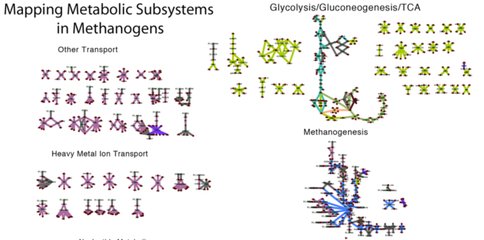2014 Annual Science Report
 University of Illinois at Urbana-Champaign
Reporting | SEP 2013 – DEC 2014
University of Illinois at Urbana-Champaign
Reporting | SEP 2013 – DEC 2014
Project 6. Mining Archaeal Genomes for Signatures of Early Life: Comparison of Metabolic Genes in Methanogens
Project Summary
Methanogenic archaea derive energy from simple starting materials, producing methane and carbon dioxide in the process. The chemical simplicity of the growth substrates and versatility of the organisms in extreme environments provide for a possibility that they could exist on other planets. By characterizing the evolution of methanogens from the most simple to most complex organism as well as their growth characteristics under controlled environments, we hope to address the question as to whether they could exist on planets such as Mars, where bursts of methane have been seen, yet no source has yet been identified.
Project Progress
Methanogenic archaea have the unique ability to generate methane from simple carbon substrates like CO2, hydrogen, acetate, methanol, and methylamines in anaerobic environments typical to early life on earth and perhaps other planets like Mars. Our focus is on the effects of the microenvironment on the metabolism of methanogens. To process each substrate, the organisms had to evolve unique pathways with vastly different thermodynamic behavior. In our Archaea 2014 paper, we characterized their physical properties and constructed a preliminary kinetic model for the methanogenesis pathways in the methanogenic archaeum Methanosarcina acetivorans. M. acetivorans can process a large number of substrates that are taken up individually in other diverse, but related methanogens like M. barkeri and Methanococcus jannaschii.
26 reactions constitute the methanogenesis pathways in M. acetivorans. To date we have analyzed its transcriptome (genomic mRNA and RNA) for cells growing on CO, methanol, trimethylamine and acetate from both a static and a dynamic perspective leveraging recent whole transcriptome shotgun sequencing (RNAseq) and computational analyses.
Using the RNA expression profiles for static snapshots of cell populations, we identified genes differentially expressed among the four conditions and have mapped these genes to their metabolic function. With continued analysis of the metabolic associations as well as comparison of metabolic and genetic similarities to other methanogens, we hope to gain an understanding of how the organism evolved the metabolic optimization strategies needed to live near the thermodynamic limit. Additionally, using a transcription inhibitor, we halted RNA production allowing snapshots of the degradation of RNA up to two hours after inhibition, providing a dynamic picture of the transcriptome degradation. Ongoing computational analyses of RNA lifetimes aim to investigate the timescales of metabolic relaxation and substrate switching. A manuscript presenting this data is in preparation.
To look for yet broader evolutionary relationships in metabolic pathways functioning under anaerobic conditions, we are leveraging our previous simulations and experiments on E. coli and yeast to compare the metabolic networks among three domains of life i.e. E. coli (Bacteria), Saccharomyces cerevisiae (Eukaryotes) and Methanosarcina spp. (Archaea). Metabolic models exist for these three organisms that compile of all the biochemical knowledge available about them in the literature. They account for the biochemical activity of 1366/4377 genes in E. coli, 904/5770 genes in S. cerevisiae and 745/4524 genes in M. acetivorans. In E. coli and yeast, glucose is used to generate both energy and biomass by utilizing glycolysis, TCA cycle, and oxidative phosphorylation. Lacking any glucose transporters, methanogens use methanogenesis for energy production which also produces acetyl-CoA which enters the TCA cycle and the gluconeogenic pathway to produce its biomass precursors. The comparative studies on the transporters for ions and metals continue to reveal strikingly different evolutionary decisions how the organism interact with their environment and is the basis of another manuscript.
Finally, building upon the work performed in the 2014 Archaea paper, the Luthey-Schulten, Cann and Fouke Laboratories are collaborating to build a new anaerobic growth chamber and microfluidic devices at the Institute for Genomic Biology designed to enable new research into methanogens under many different substrate and soil conditions. Particularly relevant to the NASA projects are the time dependent export of methane and CO2 and the uptake of acetate and CO.
Publications
-
Peterson, J. R., Labhsetwar, P., Ellermeier, J. R., Kohler, P. R. A., Jain, A., Ha, T., … Luthey-Schulten, Z. (2014). Towards a Computational Model of a Methane Producing Archaeum. Archaea, 2014, 1–18. doi:10.1155/2014/898453
-
PROJECT INVESTIGATORS:
-
PROJECT MEMBERS:
Zaida Luthey-Schulten
Project Investigator
Isaac Cann
Co-Investigator
Bruce Fouke
Co-Investigator
Piyush Labhsetwar
Co-Investigator
Shen Shee Thor
Collaborator
-
RELATED OBJECTIVES:
Objective 1.1
Formation and evolution of habitable planets.
Objective 2.1
Mars exploration.
Objective 3.1
Sources of prebiotic materials and catalysts
Objective 3.2
Origins and evolution of functional biomolecules
Objective 3.3
Origins of energy transduction
Objective 3.4
Origins of cellularity and protobiological systems
Objective 4.1
Earth's early biosphere.
Objective 4.2
Production of complex life.
Objective 5.1
Environment-dependent, molecular evolution in microorganisms
Objective 5.2
Co-evolution of microbial communities
Objective 5.3
Biochemical adaptation to extreme environments
Objective 6.1
Effects of environmental changes on microbial ecosystems
Objective 6.2
Adaptation and evolution of life beyond Earth
Objective 7.1
Biosignatures to be sought in Solar System materials
Objective 7.2
Biosignatures to be sought in nearby planetary systems
